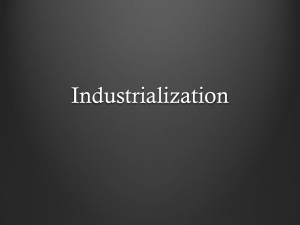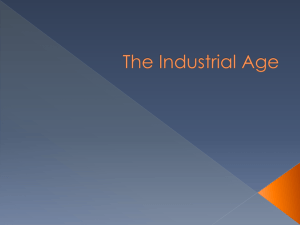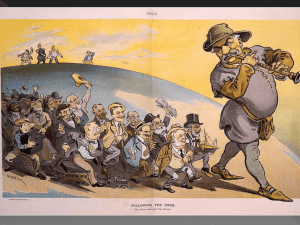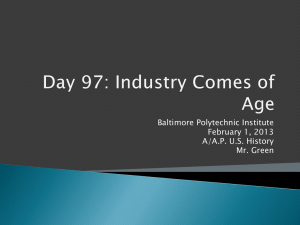Chapter 18
advertisement
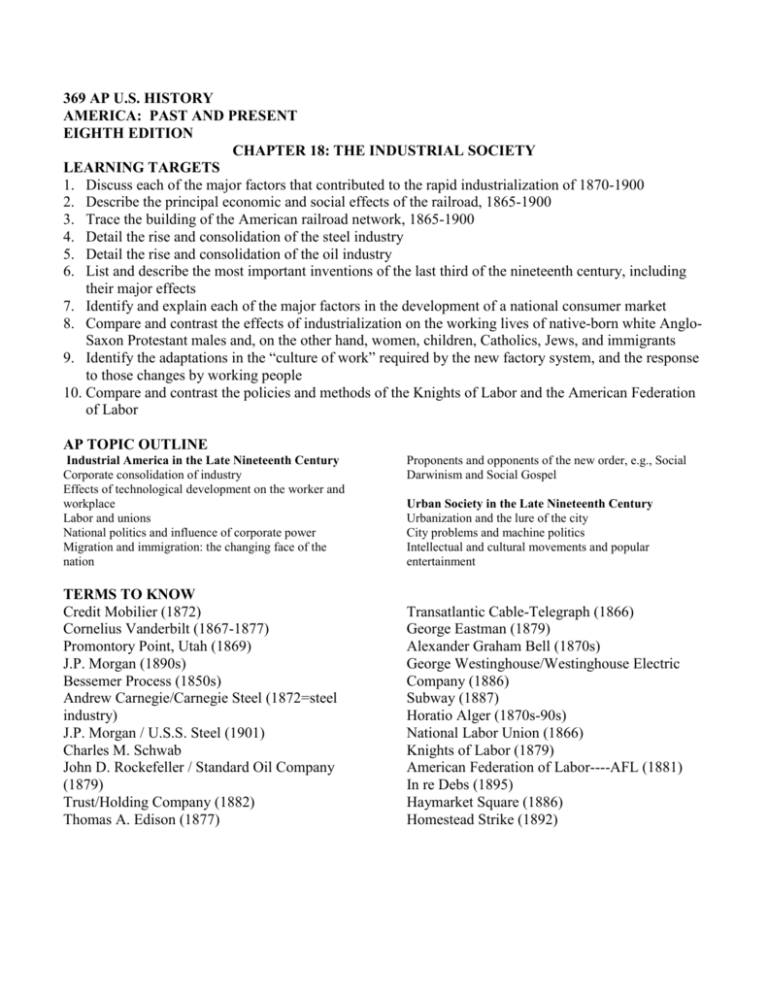
369 AP U.S. HISTORY AMERICA: PAST AND PRESENT EIGHTH EDITION CHAPTER 18: THE INDUSTRIAL SOCIETY LEARNING TARGETS 1. Discuss each of the major factors that contributed to the rapid industrialization of 1870-1900 2. Describe the principal economic and social effects of the railroad, 1865-1900 3. Trace the building of the American railroad network, 1865-1900 4. Detail the rise and consolidation of the steel industry 5. Detail the rise and consolidation of the oil industry 6. List and describe the most important inventions of the last third of the nineteenth century, including their major effects 7. Identify and explain each of the major factors in the development of a national consumer market 8. Compare and contrast the effects of industrialization on the working lives of native-born white AngloSaxon Protestant males and, on the other hand, women, children, Catholics, Jews, and immigrants 9. Identify the adaptations in the “culture of work” required by the new factory system, and the response to those changes by working people 10. Compare and contrast the policies and methods of the Knights of Labor and the American Federation of Labor AP TOPIC OUTLINE Industrial America in the Late Nineteenth Century Corporate consolidation of industry Effects of technological development on the worker and workplace Labor and unions National politics and influence of corporate power Migration and immigration: the changing face of the nation TERMS TO KNOW Credit Mobilier (1872) Cornelius Vanderbilt (1867-1877) Promontory Point, Utah (1869) J.P. Morgan (1890s) Bessemer Process (1850s) Andrew Carnegie/Carnegie Steel (1872=steel industry) J.P. Morgan / U.S.S. Steel (1901) Charles M. Schwab John D. Rockefeller / Standard Oil Company (1879) Trust/Holding Company (1882) Thomas A. Edison (1877) Proponents and opponents of the new order, e.g., Social Darwinism and Social Gospel Urban Society in the Late Nineteenth Century Urbanization and the lure of the city City problems and machine politics Intellectual and cultural movements and popular entertainment Transatlantic Cable-Telegraph (1866) George Eastman (1879) Alexander Graham Bell (1870s) George Westinghouse/Westinghouse Electric Company (1886) Subway (1887) Horatio Alger (1870s-90s) National Labor Union (1866) Knights of Labor (1879) American Federation of Labor----AFL (1881) In re Debs (1895) Haymarket Square (1886) Homestead Strike (1892) CHAPTER 18 ID’S 1872 Credit Mobilier Pg. 515 After the Civil War, railroads started popping up all over the country. It took huge amounts of capital to build and run a railroad. The railroad companies got much of their money from investors and the rest from the government. The government gave land and money to the railroads who then took advantage of it. One way the railroad companies used to get rich off the government grants was for the owners of one company to start a separate construction company to which they gave large contracts. One of these fake construction companies was the Credit Mobilier. It was started by the owners of the Union Pacific. They bribed congressmen and state legislators to avoid being investigated. 1867-1877 Cornelius Vanderbilt Pg. 516 Before the Civil War, railroads had completed with each other and had adopted conflicting schedules and different gauges tracks. After the Civil War, railroads companies got together and standardized basically everything. Railroad companies merged and four great trunk lines developed in the Northeast. One of these trunk lines was Cornelius Vanderbilt’s New York Central railroad. Vanderbilt was almost 70 when he got into railroads, but he took over New York Central, merged it with other lines to form a track for New York City to Buffalo, and ended up with over 4500 miles of track. 1869 Promontory Point, Utah Pgs. 517 Americans had always dreamed of a railroad connecting the Atlantic and Pacific Oceans. The railroad hadn’t been built because of sectional conflict. In 1862 and 1864, Congress passed legislation to build the first transcontinental railroad because they didn’t have to worry about the South. The Union Pacific Company was to build west form Nebraska while the Central Pacific was to build east from the Pacific Coast. Both companies received huge land grants and loans to help them build. On May 10, 1969, the two companies met at Promontory Point. The two presidents, General Grenville M. Dodge from Union Pacific and Charles Crocker from Central Pacific, drove in a gold spike and completed the first transcontinental railroad. 1890s J. P. Morgan Pg. 519 After the railroad boom, there were many railroads and fierce competition between them for freight and passengers. They used many tactics to lure businessmen and passengers. Many railroads went bankrupt when they tried to combine. They turned to bankers. J.P. Morgan was one such banker. He was the head of J.P. Morgan and Company in New York and was the most powerful man in American finance. He disliked competition, so he formed traffic sharing agreements for some railroads, refinanced other, and with a few other bankers, took over the railroad industry. They cut fixed costs and debt, stabilized rates, created new stock, destroyed competition and rebates, and put control with hand-picked trustees. Morgan and these bankers reorganized and brought stability to the railroad industry. 1850’s Bessemer Process Pg. 520 The Bessemer process was a process of creating steel developed simultaneously by Henry Bessemer in England and William Kelly in the U.S. They discovered that a blast of hot air through molten iron burned away carbon and impurities and left a more uniform and durable steel. The Bessemer process dealt with huge amounts of molten metal at a time. 1872 Andrew Carnegie/Carnegie Steel Pgs. 520-21 The Bessemer process needed huge facilities, capital, raw materials and sophisticated production techniques. Only the very rich could afford to get into the steel industry. One of these millionaires was Andrew Carnegie who became the master of the steel industry. Carnegie was born in Scotland and worked on the railroads until he was 24. He became rich through investments and got into the steel industry in 1872. He built J. Edgar Thompson Steel Works just south of Pittsburgh and attracted able subordinates. Carnegie worked his employees hard, and paid the factory workers little. He also crushed a strike in 1892. He got the contract for the Brooklyn Bridge, and converted one of his factories to constructural steel for beams and angles. He became the king of the steel kingdom. 1901 J.P. Morgan and U.S. Steel Pg. 521 In 1900, Carnegie wanted to sell Carnegie Steel because he wanted to devote his whole time to philanthropic activities. J.P. Morgan was Carnegie’s biggest competitor and offered to buy him out. Carnegie named a price, Morgan agreed to it, and the deal was done. Morgan became the master of U.S. Steel. He owned three-fifths of all steel industry in the U.S. 1901 Charles M. Schwab Pgs. 521 Charles M. Schwab was one of the two top people under Carnegie in the steel industry. He worked for Carnegie, and when Morgan wanted to buy Carnegie out, Schwab facilitated the deal by getting the price from Carnegie and giving it to Morgan. 1879 John D. Rockefeller/Standard Oil Company Pgs. 521-23 Before 1850, there really had been no market for petroleum or oil anywhere. After 1859, when the first oil well was drilled, the world experienced an oil boom. It wasn’t used in gasoline, but it was used for kerosene, paint, wax, varnish, naphtha, oil, grease, and paraffin. At first, the oil industry was completely chaotic. Then came John D. Rockefeller. In 1863 he built the Standard Oil Company in Cleveland. Rockefeller was ruthless and destroyed or took over his competition. He loved efficiency and exactness. He cut costs everywhere he could. He changed small things that amounted to big savings in large-scale production. His top chemist, Herman Frasch, was always coming up with new ways to better refine petroleum. By 1879, Rockefeller controlled almost the whole oil industry. He owned refineries, wells, tankers, cars, pipelines. He had basically monopolized the whole industry. He set up the Standard Oil Trust to manage all of it, and earned billions of dollars. 1882 Trust Pg. 522 In order to manage his monopoly of the oil industry, Standard Oil’s attorney, Samuel T.C. Dodd set up the Standard Oil Trust. He created a board of nine trustees to control and manage all of Standard’s properties. All the stockholders exchanged their stock for trust certificates on which they got paid dividends. The Trust centralized control of all of Standard’s holdings. 1890’s Holding Company 1877 Thomas Alva Edison Pg. 523 Pgs. 523-27 Thomas A. Edison was one of the most important inventors of the late 19th century. He had little formal education but created products that changed life forever. At Menlo Park, New Jersey, Edison brought people together to work on specific problems and created the first modern research laboratory. In 1877 the laboratory turned out the phonograph. In 1879, it produced the light bulb. With backing from J.P. Morgan, Edison created the Edison Illuminating Company and built a power station in New York City. In 1882, he tested his system and lit up Morgan’s house, the stock exchange, the New York Times, and many other buildings. Power stations exploded across the U.S. 1966 Transatlantic Cable Pg. 526 In 1866 Cyrus W. Field improved the transatlantic cable linking the telegraph systems of the U.S. and Europe. After this, other cables linked the U.S. with the Orient, South America, and Africa. News and information could be disseminated faster and with more accuracy than ever before. 1879 George Eastman Pg. 526 In 1879 George Eastman invented a process of coating gelatin on photographic dry plates. This process led to celluloid film and motion pictures. He stared selling a camera called the Kodak and revolutionized the picture industry. 1870’s Alexander Graham Bell Pg. 526-27 Alexander Graham Bell settled in Boston in 1871 and started to work with ways of helping the deaf hear. He developed a metal disk that converted sound to electricity and back again. This became the basis for the telephone. He stated the Bell Telephone Company and set up phone lines all over the country. By 1895, the American Telephone and Telegraph Company, the product of the Bell Telephone Company, controlled the communications industry. 1886 George Washington/Westinghouse Electric Company Pg. 527 When Edison set up his power station on Pearl Street, he based his system on low-voltage direct current that couldn’t be transmitted very far. George Westinghouse figured out the advantages of high-voltage alternating currents and formed the Westinghouse Electric Company in 1886. He and inventor Nikola Tesla developed an alternating current motor that could convert electricity into mechanical power. 1887 Subway Pg. 527 After Westinghouse’s motor, Frank J. Srague electrified the Richmond streetcar system in1887. Other cities followed with streetcars, subways and trolleys. 1870’s-1890’s Horatio Alger Wrote Rags to Riches about poor people getting really rich. Pgs. 532 & 589 1866 National Labor Union Pg. 532 Throughout the 19th century, labor unions were very weak. When the national economy developed, labor unions developed with it. In 1866, William H. Sylvis started the National Labor Union. It was made up of several different unions that had united. Sylvis wanted long-range humanitarian reforms like workers’ cooperatives. He attracted many people, but the union died with him in 1869. 1879 Knights of Labor Pgs. 532-33 After the National Labor Union died out, a group of Philadelphia garment workers organized the Noble and Holy Order of the Knights of Labor, a secret fraternal order. In 1879, Terence V. Powderly was elected Grand Mater Workman. He ended the secrecy and opened membership up to anyone regardless of religion, sex, or race. He even welcomed employers. The Knights pitted the producers against the nonproducers. Employees weren’t supposed to strike, but the union fought for the 8-hour day, abolition of child and prisoner labor, and utopian reform. The Knights did strike and won a victory against Jay Gould’s Missouri Pacific Railroad. Membership reached record heights. Gould struck back later, and the organization wasn’t equipped to deal with so many members so the Knights died out. 1881 American Federation of Labor Pgs. 533 After the Knights of Labor died, Samuel Gompers started the American Federation of Labor. The Federation was a loose alliance of different craft unions. It only included skilled workers who worked for specific political objectives. The Federation realized that the workers would always be workers. They just wanted the rest of the world to recognize their place in society. They worked for shorter hours, higher wages, and better working conditions. They would strike and boycott, but if they were treated fairly, they would be a stable labor force. 1895 In re Debs Pg. 535 While workers were able to strike and boycott, employers also had weapons they could use. They could fire workers who joined unions, hire scabs to replace strikers, and use a court injunction. The court injunction said that workers could not interfere with their employers’ business. The Supreme Court upheld the use of injunctions with In re Debs 1886 Haymarket Square Pgs. 535 As employers used their weapons against the unions, violence broke out among workers. The worst incident took place in Chicago. In May 1886 police shot and killed two workers who were striking at the McCormick Harvester works. The next evening, there was a protest at Haymarket Square. It was peaceful, but when the police ordered the protesters to disperse, someone threw a dynamite bomb. The police opened fire on the crowd and killed four people. 1892 Homestead Strike Pg. 536 In 1892, Henry Clay Frick and his partner lowered wages at the Homestead steel plant. The Amalgamated Iron and Steel Workers, a part of the AFL, struck, and were locked out of the plant. The workers surrounded the plant, and Frick hired a small army of Pinkerton detectives to drive them off. The workers forced the detectives to surrender, but were forced to go back to work by the Pennsylvania militia. In the interim, an anarchist named Alexander Berkman walked into Frick’s office, shot him, and stabbed him several times, but did not kill him. BUSINESS-LABOR TERMINOLOGY I. TYPES OF BUSINESS IN THE U.S. Sole Proprietor business conducted by a single owner. Partnership businessman invites other men to join him as partners; they share the profits and help to determine policy, but are also liable for any losses. Corporations (Shares of stock, stockholders, dividends) company offering shares of ownership, called stock, to people who want to invest; operates under charter from the government. Advantages are limited liability; way to raise money. Pool Monopoly exclusive control of the supply of any product or service; able to control prices. Trust combination formed to reduce competition in the same line of business; stockholders give stock and voting privileges to trustees who can then control company. Holding company corporation owning enough stock in several other corporations to control them. Merger two or more companies combine to form one large corporation which can effectively control production. Conglomerate large corporation buys several smaller companies unrelated to its product line Oligopoly a market that is dominated by a few large firms. Firms that keep their prices close together and compete in other ways (i.e. advertising, style, quality, new features). It discourages competition. Horizontal Vertical TACTICS USED BY BUSINESS-LABOR MANAGEMENT scabs-strikebreakers lockout Injunction (contempt of court) publicity (public relations) use of financial resources yellow dog contract blacklist spies (stool pigeons) company guards (goons) company town trade associations LABOR boycott sit-down sabotage picketing slowdown Walkout public relations collective bargaining blue flue strike (strike fund) chaos (create havoc all over the system) ROLE OF GOVERNMENT IN BUSINESS-LABOR RELATIONSHIP National Guard / Army Mediation Arbitration Injunction LABOR HISTORY In 1881-1995 = 36,757 strikes in the U.S. involving six million workers. Unions won approximately ½ of all of the strikes in the 1880’s and 1890’s. Between 1875-1910 state troops were called out nearly 500 times to deal with labor unrest. Just over half of all workers were in the coal, construction, transportation and garment industries. Historians have referred to this age as a period of history where the HAVES VS. HAVE NOTS. UNIONS National Labor Union (1866) – established by William H. Sylvus (who died in 1869 and with his death the organization also died). o Represented skilled workers; local unions united into a single national organization o Represented long range humanitarian reform o Established a workers cooperative Knights of Labor (1869) – established by Uriah S. Stevens and later Terence V. Powderly (elected 1879) o Strongly socialistic in outlook. o Wanted to unite all labor regardless of skill, creed, sex or color (did include blacks and females). o Said that workers shouldn’t strike o Sought 8 hour day abolition of child and prison labor believed in utopian reform - sweep away trusts - pro-prohibition - workers should establish “worker run factories” Demise: Brought about by the Haymarket Square Riot (1886) strike at McCormack Harvestor Plant in Chicago - two workers were killed by police at the factory protest meeting was held in Chicago at Haymarket Square approximately 3,000 people attended; when told by police to disperse, workers stay dynamite is thrown = 1 police person killed and 6 wounded 4 demonstrators die from police guns Effect: Labor is stamped as “Radical” - 8 “Anarchists” are convicted of murder (4 hung, 1 suicide, and 4 are pardoned by the governor) Established in Chicago = The Armory, Fort Sheridan and the Great Lakes Naval Training Station. Significance: This strike links labor unions and anarchism in the public mind American Federation of Labor (AFL) (1881) – established by Samuel Gompers Loose alliance of national craft unions, skilled workers - improve the lot of workers (so they can get a greater share of the rewards) = higher wages, shorter hours, better working conditions - would not oppose monopolies or trusts - would use strikes or boycotts in a limited fashion - very pragmatic and accepted capitalism Impediment: Homestead Steel Strike (1892) – an affiliate of the AFL called the Amalgamated Association of Iron and Steel Workers (one of the largest and best organized labor unions who in 1889 had received the largest pay increase ever gained by a union) was locked out by Henry Clay Frick, the manager of Andrew Carnegie’s Steel Co., when after 3 months of negotiation no agreement to a pay cut was agreed to. Frick and Carnegie were determined to break the union. Events: Step 1 Frick hires 300 Pinkertons (arrived by barge and met by 10,000 armed strikers, gunfire ensues ending in the death of 9 strikers and 7 Pinkertons along with many serious injuries) Step 2 Governor calls out 8,000 militia (including the U.S. Army). Frick hires strikebreakers, resumed production and crushes the union. In the midst of this action an anarchist, Alexander Berkman shoots Frick (who survives). Significance: The steel industry became nonunion and remained so until the 1930’s. This strike underscored the difficulty of the union to prevail against the combined power of the corporation and the government. American Railway Union (1893) – Eugene Debs succeeded in organizing railway workers into one of the Largest unions of its time. Initially a believer in capitalism he turns to socialism when he repeatedly observes the unfair collusion between business and government throughout the era. (Between 1900 and 1920 Debs was the Socialist’s party standard bearer in five presidential elections). Demise: Pullman Strike (1894) - George Pullman, the inventor of the railroad sleeping car fired 1/3 of his workers and cut wages of the remaining workers by 30% when trying to adjust to the conditions brought about by the Panic of 1893. Many of the workers of the Pullman Car Company lived in his company town of Pullman. Although cutting their wages or laying them off, he didn’t cut prices for homes, food or services. Events: Debs orders a strike when Pullman refuses to negotiate with the ARU over cuts. Workers refuse to work while other unions go out in sympathy refusing to work on any trains that used a Pullman car. (Mail was interrupted along with food and fuel delivery). The government issues an injunction. Debs defies the order (and is held in contempt of court for 6 months: In re Debs). Federal troops are called out and break the strike. Significance: Labor unions emerge with distinct disadvantages in conflicts with organized labor. Socialism Architects of a Socialistic system. Marx and Engels – Communist Manifesto (1848) and Das Kapital 1867* Henry George – Progress and Poverty (1879) Edward Bellamy – Looking Backward (1887) Jacob Riis – How the Other Half Lives (1890’s) Philosophy -began as an idea opposed capitalism. (Marx argued that the inequities of income, the profit motive, monopolies, greed and the condition of the working class would destroy capitalism.) -based on the fact that society should be deeply concerned with dignity, worth, and rights: need to elevate the lowest members of society to a level equal to their status in the Creator’s realm -economic system which would redistribute the wealth of society on a more even basis -for the average worker this concept offered a lifestyle that seemed impossible to attain during the Industrialization era. Central Economic Actions of Socialism Max argued that economic conditions determine the course of history. History is a story of the HAVES BOURGEOISIE PROFIT VS. VS. VS. According to Marx the steps to socialism include: THE HAVE-NOTS PROLETARIATS SURPLUS VALUE 1) reorganize the economy to improve the economic status of the masses. Under capitalism an inequality of income due to the profit motive does not benefit everyone, promotes greed and brings down the condition of the working class. Marx’s idea was to take the factors of production out of the hands of the industrialists so that profits could be redistributed to the workers. 2) reorganize the economy through a process of nationalization / collectivization Marx’s concept of socialism evolved into two different types Democratic Socialism Marxist / Communism How to bring this reorganization about? Partial or Total Nationalization / Collectivism Compensation to the Owner / No Compensation Government or No Government / Anarchy FIVE STAGES TO PERFECT COMMUNISM STAGE 1 Revolution – The Proletariat overcomes the Bourgeoisie STAGE 2 A temporary government composed of revolutionary leaders is set up to --Indoctrinate the population with communist ideals --Abolish private ownership; the means of production are turned over to the Proletariat STAGE 3 The Communist Party is established to control and plan the economy, to modernize and industrialize the country. STAGE 4 Eventually there will be no need for government, “The State (Communist Party) will wither away.” STAGE 5 Perfect communism will be achieved: Equality, Cooperation and No need for government
